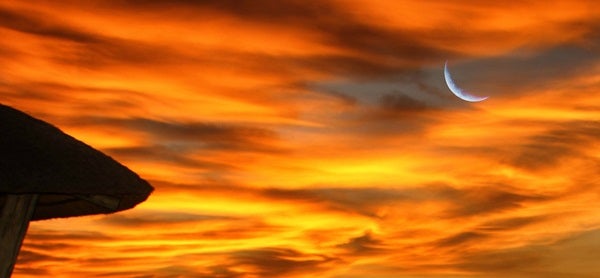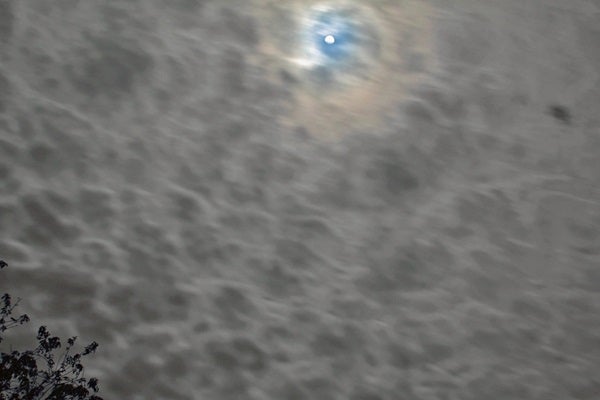The other night, I saw a blue Moon shining through cirrocumulus clouds and felt a surge of delight. Blue Moons aren’t just calendric events but true-blue atmospheric phenomena — requiring only a small dose of curiosity and a tilt of the head to see, given the right conditions. There are several ways to see blue Moons. I’ll start with the most common.
The aureole effect
The coming of winter in the Northern Hemisphere brings lots of high cloud formations, which can produce blue Moons. And now is as good a time as any to start looking. For instance, on the particular night above, tiny water droplets in a cloud diffracted bright moonlight to form a lunar aureole (see the photograph to the right). The smaller the droplet, the larger the aureole, and this one was quite large, on the order of 8°.
Related to coronae formed by our atmosphere, the aureole appears as a dusky orange ring with a small blue (sometimes green) core surrounding the Moon. Usually you will see the Moon shining white through the cloud. But if you’re patient or lucky, “once in a blue Moon” you may catch glimpses of it appearing pale blue or aqua.
The effect is quite delicate and may take an experienced eye, which is why you should continually observe and record what you see. The late Dutch astronomer Marcel Minnaert, author of the wonderful book The Nature of Light and Colour in the Open Air (Dover, 1954), warned that the effect may last but a fraction of a second. Under just-right conditions, however, it can last longer.
A more obvious blue Moon occurs when a Full Moon shines through altostratus clouds. As it does, it forms a dense aureole that transforms the Moon’s face into a dim and fuzzy blue light. You may have to monitor the situation periodically to see the blue Moon effect because the clouds are constantly changing, bringing regions of different optical thickness and particle size into view. I’ve noticed that the blue Moon lingers most when the
Moon is near the horizon.
In Color and Light in Nature (Cambridge University Press, 1995), authors David K. Lynch and William Livingston note that the reason for these types of blue Moons involves a “no man’s land where the wavelength of light is comparable to the particle size (0.1 to 10 micrometers).” Under these conditions, the scattered particles transmit some colors and scatter others.
Contrast and afterimage
One of the most dynamic blue Moons occurs when intense orange cirrus clouds surround it. The effect is at first a result of simultaneous contrast, when a small area of color (a white Moon) takes on the complimentary hue of the surrounding color (the orange clouds).
If you stare at this optical illusion for a while, another one will enhance it: an afterimage. Prolonged staring at an intense orange cloudscape will exhaust the ability of the eye’s red-sensitive cone cells (and many of the green ones) to fire messages to the brain. So when you look at the Moon, it’s mainly the eye’s blue cells that continue to fire, causing the brain to see it as blue.
When large volcanic eruptions eject prodigious amounts of sulfur dioxide into Earth’s stratosphere, the gas can cling to particles and form aerosols wider than the wavelength of red light (about 1 to 2 microns), which wind currents can transport around the globe. When seen through this aerosol haze, the Moon may appear blue because the particles deflect red light away from the Moon’s position at angles greater than they move blue light, creating a special kind of aureole called a Bishop’s ring. And while lunar aureoles are generally a few degrees across, Bishop’s rings measure between 20° and 60° across.
Volcanic aerosol clouds can also create prolonged and colorful twilights (lavender to red), which can produce simultaneous contrast blue Moons as well. For example, the longer you stare at the red of the sky in the photo at the top of the page, the bluer the Moon appears.
As always, send your colorful comments to sjomeara31@gmail.com.












